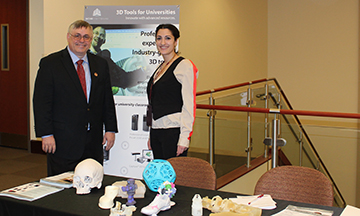
Hoping to spur creative and entrepreneurial innovation, Florida State University is adding 3D printing technology to its new innovation lab being developed by the College of Communication and Information.
3D Systems, the company that invented 3D printing, donated Cube 3 and CubePro 3D printers, a Sense 3D Scanner and software programs that include an accompanying 3D mouse for digital sculpting to Florida State to give students open access to the emerging technology.
“We are committed to empowering this generation of students with tomorrow’s skills today, and we believe that at the core of tomorrow’s necessary workforce skills is 3D design and printing,” said Leanne Gluck, director of social impact for 3D Systems. “3D design and printing not only democratizes local production for established companies and professionals, but it also enables students to be the inventor, the designer, the artist, and to have the tools to start their own business if they want to.”
The announcement of the donation came as the university wrapped up its Stacking Layers conference, a one-of-a-kind event that brought some of the nation’s top 3D printing experts to Florida State to increase public awareness of, and explore new ways to use the technology in research, business and everyday life.
“This gift will have a tremendous impact on FSU students,” said Larry Dennis, dean of the College of Communication and Information. “Providing students with ongoing access to state-of-the-art 3D printing technology is a great way to engage students and inspire them to think innovatively about the impact of this technology. 3D Systems’ gift has helped create a fantastic opportunity for FSU’s students and faculty.”

Larry Dennis, dean of FSU's College of Communication and Information, and Leanne Gluck, director of Social Impact for 3D Systems, are seen here at a recent 3D printing conference on campus.
Ken Baldauf, director of FSU’s Program in Interdisciplinary Computing, said the gift is a kick-start for the university’s investment in this type of technology and training for students.
“The whole point is it will be a place where students can have free and easy access to the technology,” he said.
The donation came as the university wrapped up a 3D printing conference that featured experts in 3D printing and manufacturing from all over the country as well as an exhibition hall featuring the latest creations from 3D printers.
3D printing, at its most basic level, involves the use of a machine that “prints” three-dimensional images by stacking layers of material on top of one another. Smaller printers are often used to make toys or ceramics, while larger ones can make almost anything.
Medical researchers are looking at new capabilities with organ tissue and cells to see if one day, new organs can be completely manufactured. Other researchers are trying to build homes with giant 3D printers.
The overall lab for the university is still in development, but training classes are expected to be available in the near future for students who are interested in getting involved with 3D printing technology.




